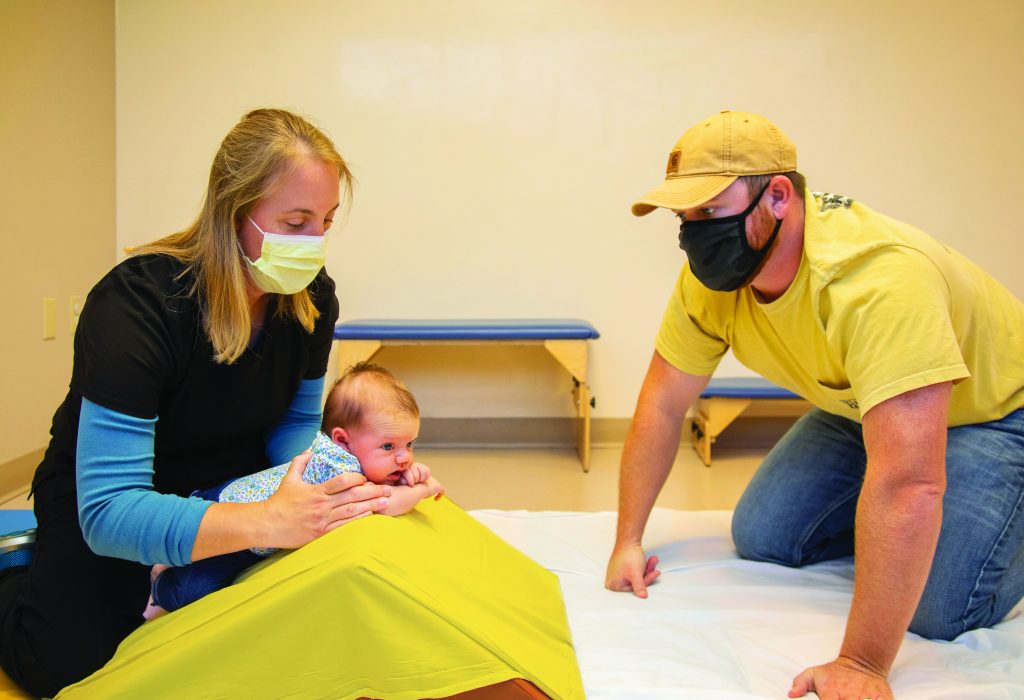
Tummy Time Tips For Your Baby
By Katie Goodlet, PT
A recent Boone Baby, named Daisy Dye, was about to go to her two-week checkup with her parents, Brent and Lilly, when her dad noticed that her head was a little flat. At her appointment, the pediatrician confirmed that the baby had plagiocephaly. She was referred to Boone Therapy and started physical therapy at just three weeks old. One of the things Daisy began working on was tummy time.
Tummy time is critical for infant development. Infants who do not get enough tummy time may have delayed motor development, a higher risk for sensory and coordination disorders, and an irregular head shape. Tummy time is needed for strengthening motor and sensory development and head shape.
More parents are using equipment such as bouncy seats, swings and seats. This can be problematic because the infant spends most of their time with pressure on the back of their head, either from the equipment, the floor, their bed, or their parent’s arm.
Infants must sleep on their back to reduce the risk of Sudden Infant Death Syndrome or SIDS, however, that does not mean that infants should not ever be on their tummy. From the day you leave the hospital, any time your infant is awake and has your attentive supervision, they can work on tummy time. Be sure to remove all distractions, including your phone, so you can actively watch your child.
The recommended length of tummy time varies for each infant. A newborn infant will probably spend just a couple of minutes on their tummy before they fall asleep and need to be moved onto their back. To increase a newborn’s tummy time, try to do it right before each feeding. A hungry infant is more likely to turn towards an object touching their face — in this case, the floor — which will help build strength as they lift their head.
Older infants can tolerate several minutes of tummy time at once. To assist with tummy time, you can use a ball, have your infant lie on her tummy over a blanket roll or wedge, have your infant lie on your forearm, or get down on your tummy as well, so your child can see your face.
Laying your baby on your chest is also a great way to get in tummy time. Make sure you are also laying your infant on the floor for tummy time a couple of times a day. Keep your infant on their tummy until they fall asleep or start to cry excessively. When this happens, either pick your infant up or roll them onto their back.
Tummy time is critical for infants with torticollis or plagiocephaly, but some infants who get plenty of tummy time still end up with torticollis or plagiocephaly.
Torticollis, which is caused by tight muscles in the neck, is a turning or tilting of the head which limits motion in the opposite direction. Plagiocephaly is an asymmetrical head shape — the back of the head may be flat or asymmetrical, or the baby’s head is wider or longer than normal. Both conditions can be caused by spending too much time in equipment or the infant’s position in utero before birth.
Your infant may need to be seen by a physical therapist for stretching and strengthening exercises. These exercises focus on stretching tight muscles and strengthening weak ones. For instance, a baby who looks to the left and tilts their head to the right will need exercises to help them look to the right and tilt to the left.
Treating torticollis is necessary to prevent further motor delays. An infant who only can look to the left will not use her right side as much, which can lead to weakness and decreased coordination on the right. This will impact rolling, bringing toys to midline and other activities as your child grows — for example, they may only be able to climb steps with their dominant leg first instead of alternating feet on each step. Untreated plagiocephaly may result in a misshapen head requiring further medical intervention.
Both conditions are treatable, but parent education, activity modification, and stretching and strengthening are a must. If you suspect your baby has torticollis or plagiocephaly, talk to your pediatrician to get a referral to physical therapy at Boone Therapy.